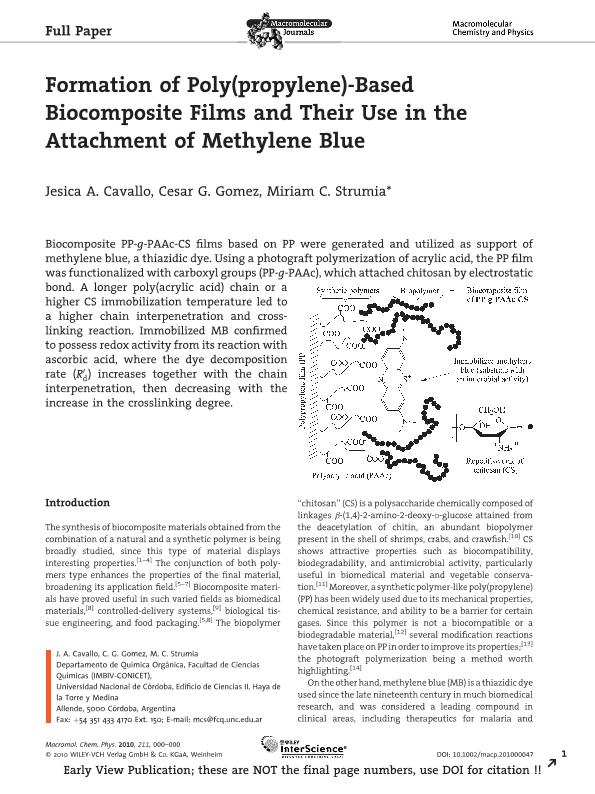Mostrar el registro sencillo del ítem
dc.contributor.author
Cavallo, Jesica Anabel

dc.contributor.author
Gomez, Cesar Gerardo

dc.contributor.author
Strumia, Miriam Cristina

dc.date.available
2019-09-25T17:02:04Z
dc.date.issued
2010-08
dc.identifier.citation
Cavallo, Jesica Anabel; Gomez, Cesar Gerardo; Strumia, Miriam Cristina; Formation of poly(propylene)-based biocomposite films and their use in the attachment of methylene blue; Wiley VCH Verlag; Macromolecular Chemistry And Physics; 211; 16; 8-2010; 1793-1802
dc.identifier.issn
1022-1352
dc.identifier.uri
http://hdl.handle.net/11336/84411
dc.description.abstract
Biocomposite PP-g-PAAc-CS films based on PP were generated and utilized as support of methylene blue, a thiazidic dye. Using a photograft polymerization of acrylic acid, the PP film was functionalized with carboxyl groups (PP-g-PAAc), which attached chitosan by electrostatic bond. A longer poly(acrylic acid) chain or a higher CS immobilization temperature led to a higher chain interpenetration and crosslinking reaction. Immobilized MB confirmed to possess redox activity from its reaction with ascorbic acid, where the dye decomposition rate (R0d) increases together with the chain interpenetration, then decreasing with the increase in the crosslinking degree. interpenetration, then decreasing with the increase in the crosslinking degree. bond. A longer poly(acrylic acid) chain or a higher CS immobilization temperature led to a higher chain interpenetration and crosslinking reaction. Immobilized MB confirmed to possess redox activity from its reaction with ascorbic acid, where the dye decomposition rate (R0d) increases together with the chain interpenetration, then decreasing with the increase in the crosslinking degree. interpenetration, then decreasing with the increase in the crosslinking degree. methylene blue, a thiazidic dye. Using a photograft polymerization of acrylic acid, the PP film was functionalized with carboxyl groups (PP-g-PAAc), which attached chitosan by electrostatic bond. A longer poly(acrylic acid) chain or a higher CS immobilization temperature led to a higher chain interpenetration and crosslinking reaction. Immobilized MB confirmed to possess redox activity from its reaction with ascorbic acid, where the dye decomposition rate (R0d) increases together with the chain interpenetration, then decreasing with the increase in the crosslinking degree. interpenetration, then decreasing with the increase in the crosslinking degree. bond. A longer poly(acrylic acid) chain or a higher CS immobilization temperature led to a higher chain interpenetration and crosslinking reaction. Immobilized MB confirmed to possess redox activity from its reaction with ascorbic acid, where the dye decomposition rate (R0d) increases together with the chain interpenetration, then decreasing with the increase in the crosslinking degree. interpenetration, then decreasing with the increase in the crosslinking degree. -g-PAAc-CS films based on PP were generated and utilized as support of methylene blue, a thiazidic dye. Using a photograft polymerization of acrylic acid, the PP film was functionalized with carboxyl groups (PP-g-PAAc), which attached chitosan by electrostatic bond. A longer poly(acrylic acid) chain or a higher CS immobilization temperature led to a higher chain interpenetration and crosslinking reaction. Immobilized MB confirmed to possess redox activity from its reaction with ascorbic acid, where the dye decomposition rate (R0d) increases together with the chain interpenetration, then decreasing with the increase in the crosslinking degree. interpenetration, then decreasing with the increase in the crosslinking degree. bond. A longer poly(acrylic acid) chain or a higher CS immobilization temperature led to a higher chain interpenetration and crosslinking reaction. Immobilized MB confirmed to possess redox activity from its reaction with ascorbic acid, where the dye decomposition rate (R0d) increases together with the chain interpenetration, then decreasing with the increase in the crosslinking degree. interpenetration, then decreasing with the increase in the crosslinking degree. -g-PAAc), which attached chitosan by electrostatic bond. A longer poly(acrylic acid) chain or a higher CS immobilization temperature led to a higher chain interpenetration and crosslinking reaction. Immobilized MB confirmed to possess redox activity from its reaction with ascorbic acid, where the dye decomposition rate (R0d) increases together with the chain interpenetration, then decreasing with the increase in the crosslinking degree. interpenetration, then decreasing with the increase in the crosslinking degree. R0d) increases together with the chain interpenetration, then decreasing with the increase in the crosslinking degree.
dc.format
application/pdf
dc.language.iso
eng
dc.publisher
Wiley VCH Verlag

dc.rights
info:eu-repo/semantics/openAccess
dc.rights.uri
https://creativecommons.org/licenses/by-nc-sa/2.5/ar/
dc.subject
Polypropylene Based
dc.subject
Chitosan
dc.subject
Methylene Blue
dc.subject
Multilayers
dc.subject.classification
Físico-Química, Ciencia de los Polímeros, Electroquímica

dc.subject.classification
Ciencias Químicas

dc.subject.classification
CIENCIAS NATURALES Y EXACTAS

dc.title
Formation of poly(propylene)-based biocomposite films and their use in the attachment of methylene blue
dc.type
info:eu-repo/semantics/article
dc.type
info:ar-repo/semantics/artículo
dc.type
info:eu-repo/semantics/publishedVersion
dc.date.updated
2019-09-23T17:28:42Z
dc.identifier.eissn
1521-3935
dc.journal.volume
211
dc.journal.number
16
dc.journal.pagination
1793-1802
dc.journal.pais
Alemania

dc.journal.ciudad
Weinheim
dc.description.fil
Fil: Cavallo, Jesica Anabel. Consejo Nacional de Investigaciones Científicas y Técnicas. Centro Científico Tecnológico Conicet - Córdoba. Instituto Multidisciplinario de Biología Vegetal. Universidad Nacional de Córdoba. Facultad de Ciencias Exactas Físicas y Naturales. Instituto Multidisciplinario de Biología Vegetal; Argentina
dc.description.fil
Fil: Gomez, Cesar Gerardo. Universidad Nacional de Córdoba. Facultad de Ciencias Químicas. Departamento de Química Orgánica; Argentina
dc.description.fil
Fil: Strumia, Miriam Cristina. Consejo Nacional de Investigaciones Científicas y Técnicas. Centro Científico Tecnológico Conicet - Córdoba. Instituto Multidisciplinario de Biología Vegetal. Universidad Nacional de Córdoba. Facultad de Ciencias Exactas Físicas y Naturales. Instituto Multidisciplinario de Biología Vegetal; Argentina
dc.journal.title
Macromolecular Chemistry And Physics

dc.relation.alternativeid
info:eu-repo/semantics/altIdentifier/url/https://onlinelibrary.wiley.com/doi/full/10.1002/macp.201000047
dc.relation.alternativeid
info:eu-repo/semantics/altIdentifier/doi/https://doi.org/10.1002/macp.201000047
Archivos asociados
